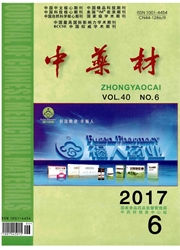

 中文摘要:
中文摘要:
目的:建立金铁锁体外高效再生体系。方法:以无菌实生苗带叶茎尖、带芽茎段和叶片为外植体,MS为基本培养基,在单因素预实验基础上,通过L9(34)正交及完全组合实验研究不同外植体和不同植物激素种类及其质量浓度对愈伤组织诱导、芽丛发生及植株再生的影响。结果:3种外植体中,带芽茎段为间接器官发生最佳材料,其在MS+6-BA 1.0 mg/L+NAA 0.1 mg/L+KT 1.0 mg/L中得愈率和芽丛分化率均为100%,30 d后不定芽分化系数达16.65,增殖系数达35.78;带叶茎尖则为直接器官发生最佳材料,其在MS+6-BA 0.1 mg/L+NAA 1.5 mg/L+KT 0.05 mg/L中培养30 d后,以"微扦插"形式进行生长,增殖系数亦可达15.45。试管苗生根则在1/2MS+6-BA0.05 mg/L+NAA 2.0 mg/L中进行,45 d后可获得生长健壮的再生植株,生根率97.50%;再生苗移栽成活率达90%以上。结论:完善了金铁锁体外快繁条件,建立了高效的植株再生体系。
 英文摘要:
英文摘要:
Objective : An efficient in vitro regeneration system of Psammosilene tunicoides was developed by optimizing the culture condition and selecting the best protocol for plant regeneration. Methods : Effectiveness of plant hormones and concentration were investi- gated through a single factor pre-experiment, and the sterile seedlings with stem tip, stem with buds and leaves were all used as ex- plants, and MS as the basic culture medium, a L9 (34 ) orthogonal experiment was designed to explore the effects of different types and concentration of plant hormones and explants on callus induction, adventitious shoot formation and plant regeneration. Results : Stem with buds was the optimal explant for indirect organogenesis with the frequency of callus induction up to 100%, which cultured on MS + 6- BA 1.0 mg/L + NAA 0. 1 mg/L + KT 1.0 mg/L,and rate of buds induced and differentiation were up to 100% ;the coefficient of differ- entiation in clump shoot was 16. 65 after 30 d and the multiplication coefficient was up to 35.78. However, the stem tip was the best ex- plant for direct organogenesis with the propagation coefficient up to 15.45 ,which cultured on MS + 6-BA 0. 1 mg/L + NAA 1.5 mg/L + KT O. 05 mg/L in 30 d later. The regeneration plant with 97.50% rooting rate was obtained which cultured on 1/2MS + 6-BA 0. 05 mg/ L + NAA 2. 0 mg/L after 45 d, and there were more than 90% of plantlets survived after transplanting. Conclusion : The current study improves condition of culture and establishes a rapid propagation system of Psammosilene tunicoides.
 同期刊论文项目
同期刊论文项目
 同项目期刊论文
同项目期刊论文
 期刊信息
期刊信息
